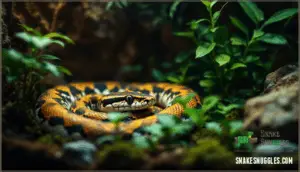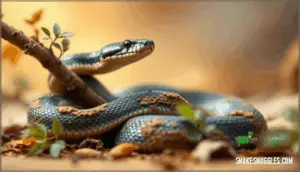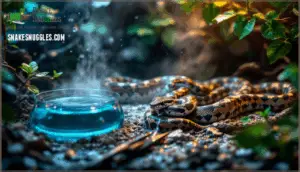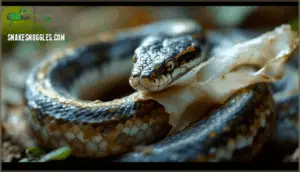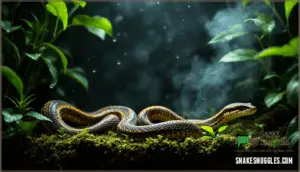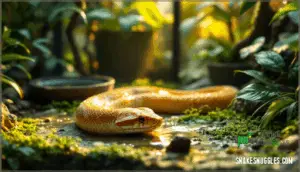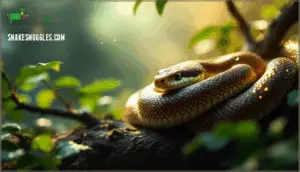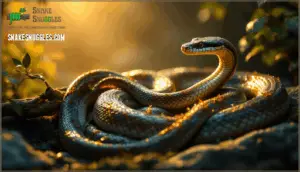This site is supported by our readers. We may earn a commission, at no cost to you, if you purchase through links.
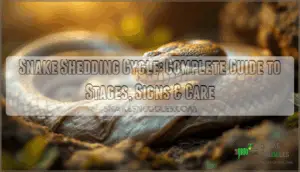
Understanding the physiological stages behind this transformation changes everything about how you care for your snake during these vulnerable periods. Each phase brings distinct signs and needs, from hormonal triggers that separate old skin from new, to the critical humidity requirements that determine whether your snake emerges with flawless scales or struggles with retained patches.
Mastering this cycle means fewer complications, healthier sheds, and a snake that moves through ecdysis with minimal stress.
Table Of Contents
- Key Takeaways
- Snake Shedding Process Explained
- Snake Shedding Cycle Stages
- Physical Changes During Shedding
- Behavioral Changes During Shedding
- Importance of Humidity in Shedding
- Assisting Snakes During Shedding
- Post-Shedding Care and Maintenance
- Common Shedding Problems and Solutions
- Factors Influencing Shedding Frequency
- Importance of Shedding for Snake Health
- Frequently Asked Questions (FAQs)
- How does a snake shed?
- How long does snake shedding take?
- Do snakes shed a lot in winter?
- Why is my snake shedding so often?
- How do you know if a snake is shedding?
- How does humidity affect a snake’s shedding cycle?
- What is the snake shedding process?
- What happens if a snake sheds a lot?
- How long does a snake shed?
- Why does my snake shed a lot during the ecdysis cycle?
- Conclusion
Key Takeaways
- Ecdysis unfolds through predictable stages—cloudy eyes, dull coloration, hiding behavior, and eventual sloughing—that signal when your snake needs specific environmental support rather than physical intervention.
- Humidity between 50-70% acts as the critical factor separating smooth sheds from stuck skin complications, making hygrometers and humid hides essential tools for preventing dysecdysis and retained eye caps.
- Shedding frequency directly correlates with age and growth rate, with juveniles molting every 3-4 weeks while adults slow to 4-12 cycles annually, reflecting the biological imperative of accommodating expanding body mass.
- Complete, intact sheds serve as diagnostic indicators of overall snake health—revealing nutritional status, parasite load, and environmental adequacy—making post-shed inspection a non-negotiable component of responsible reptile care.
Snake Shedding Process Explained
If you’ve ever watched your snake’s eyes turn cloudy or noticed its colors fade to a dull gray, you’re witnessing ecdysis—the fascinating process of skin renewal that keeps your reptile thriving. Understanding what’s happening beneath the surface transforms this natural cycle from mystery to manageable routine.
When your snake’s eyes cloud over, you’re watching ecdysis—the natural skin renewal process that transforms mystery into manageable care routine
Let’s break down the mechanics, purpose, and telltale changes that signal your snake is about to shed.
Definition of Ecdysis
Think of ecdysis as your snake’s built-in renovation system—it’s the scientific term for the regular skin-shedding process that keeps these reptiles healthy and thriving. Unlike mammals that shed dead cells gradually, snakes perform a complete skin renewal in one impressive piece. This shedding cycle is triggered by hormones that separate old skin from new, working systematically from nose to tail. The ecdysis process reveals nature’s engineering at its finest—your snake’s body knows exactly when it’s time to shed based on growth demands and environmental cues.
Here’s what makes this ecdysis stage so extraordinary:
- Hormonal signals orchestrate the entire snake shedding event
- The old layer lifts away without damaging fresh skin underneath
- Humidity acts as nature’s lubricant for smooth separation
- Rough surfaces become tools for peeling away worn skin
- Cloudy eyes signal the shedding process has begun
This shedding cycle isn’t just maintenance—it’s essential for snake growth and vitality.
Purpose of Shedding
While ecdysis describes the mechanics of skin separation, the real magic lies in what this process accomplishes for your snake’s survival. Shedding performs multiple critical functions: it allows growth renewal by making room for expanding body mass, aids skin regeneration to repair minor injuries, and eliminates external parasites trapped in old layers.
This renewal process isn’t optional—without regular ecdysis, your snake’s rigid outer covering would constrict development and compromise health. The shedding cycle fundamentally resets your snake’s protective barrier, guaranteeing peak function as it matures.
Physical and Behavioral Changes
Your snake’s transformation during ecdysis isn’t subtle—the physical and behavioral shifts are unmistakable once you know what to watch for. Pre-shedding symptoms include cloudy eyes from separating eye caps, dull skin losing its vibrant coloration, and increased hiding as snake irritability peaks. These physical alterations coincide with behavioral shifts—appetite drops, activity decreases, and posture changes signal discomfort.
- Cloudy or blue-tinted eyes indicate skin separation beneath eye caps
- Dull, grayish skin coloration replaces normal vibrant patterns
- Increased hiding and reduced activity reflect heightened stress
- Complete appetite loss occurs as metabolic focus shifts
- Defensive posture and snake irritability make touch risky
Snake Shedding Cycle Stages
Your snake’s shedding cycle follows a predictable pattern that you can learn to recognize and support. Understanding each stage helps you provide the right care at the right time, keeping your snake comfortable and healthy throughout the process.
Let’s break down what happens from the first signs all the way through to a successful shed.
Pre-Shedding Signs
If you’ve ever wondered when your snake’s about to molt, the answer starts showing up in their eyes—literally. During the preshedding phase, you’ll notice three telltale preshedding symptoms:
- Cloudy eyes emerge as fluid builds between old and new skin layers, creating that unmistakable milky appearance.
- Dull skin replaces their usual vibrant patterns—colors fade as the shedding prep begins.
- Hiding behavior intensifies alongside appetite loss, as your snake becomes more reclusive during this vulnerable stage of the shedding cycle.
These preshedding symptoms usually appear 4-7 days before the actual shed.
Separation of Old Skin
Once that opaque film clears from your snake’s eyes—a phenomenon herpetologists call the "clear phase"—the real separation begins as lymphatic fluid accumulates between the stratum corneum and the newly formed epidermal layer beneath.
This skin layering triggers the ecdysis process, loosening the old skin removal from snout to tail. You’ll see your snake rubbing against rough surfaces—branches, rocks—to initiate the shedding cycle.
The contrast between dull outer scales and vibrant new skin beneath becomes unmistakable as this skin renewal accelerates toward complete sloughing.
Sloughing and Renewal
When your snake finally breaks free from that old skin, it’s like watching a masterpiece reveal itself—fresh, gleaming scales emerging in their full glory as the dull outer layer peels away. The ecdysis process unfolds systematically: the snake rubs its snout against rough surfaces to initiate separation, then the old skin rolls backward in one continuous piece. This skin renewal exposes vibrant new scales beneath, facilitating snake growth and accommodation while supporting the renewal cycle essential for ecdysis management.
- Skin regeneration happens in stages, starting at the snout and progressing backward as the shedding cycle completes.
- One continuous piece slides away, revealing the snake’s true colors and patterns underneath the worn exterior.
- Growth accommodation becomes possible, allowing your snake to expand without constraint from restrictive old skin.
- Parasite removal occurs naturally, protecting your snake’s health during this critical renewal phase of the shedding process.
Post-Shedding Care
The real work starts once that shed comes off completely—it’s your chance to spot problems and set your snake up for a smooth recovery. Inspect the shed skin carefully, checking for retained eye caps or patches stuck to the body. These retained pieces can cause serious issues, so gently remove them with a soft, damp cloth if needed.
| Post-Shedding Task | What to Check | Action |
|---|---|---|
| Skin Inspection | Eye caps, tail tip, body patches | Remove gently with damp cloth |
| Shed Removal | Leftover skin in enclosure | Clean thoroughly; disinfect surfaces |
| Snake Hydration | Water dish levels; humidity | Refill frequently; maintain 50-70% humidity |
Your snake will drink heavily after shedding—this is normal post-shed behavior supporting skin regeneration and hydration importance. Refill the water dish multiple times and keep humidity levels steady between 50-70% through misting or a humid hide.
Resume your post-shed diet schedule within a few days, offering appropriately sized prey. Monitor scales for any retained skin or damage, as these indicate environmental or health issues requiring adjustment. This systematic post-shedding care guarantees proper snake health and readies your snake for the next cycle.
Physical Changes During Shedding
Your snake’s body goes through dramatic transformations during shedding, and recognizing these physical signs helps you understand what’s happening beneath the surface.
The changes you’ll notice aren’t random—they’re part of a perfectly choreographed process that readies your snake’s skin for renewal.
Let’s break down the specific physical shifts that occur during this vital stage.
Eye Caps and Color Change
Your snake’s cloudy eyes are actually nature’s way of signaling a major renovation is about to happen. During the shedding cycle, protective eye caps separate from the cornea, creating that distinctive milky appearance. Here’s what’s occurring:
- Eye caps lift—fluid accumulates between old and new layers, causing temporary opacity
- Vision dims—your snake experiences blurred sight during this phase of skin renewal
- Caps clear—after 4-5 days, the haze fades as shedding progresses
- New scales emerge—fresh eye health and color shift indicate successful ecdysis
This blue phase is vital for eye health and vision care during ecdysis. Understanding caps removal helps you distinguish normal shedding from stuck shed complications. The scale change signals your snake’s body is optimizing for growth and parasite removal.
Skin Coloration and Pattern
Picture your snake mid-transformation—its scales losing their signature shine, patterns blurring into shadow, colors draining like watercolors left in the rain. This isn’t illness; it’s ecdysis in motion. During the shedding process, your snake’s appearance shifts dramatically as the outer skin layer gets ready to separate:
- Coloration fades to a dull, grayish tone as the old skin loosens
- Scale patterns blur, reducing the definition of your snake’s natural camouflage
- Pigmentation dulls, especially in iridescent species that temporarily lose their shimmer
- Belly coloration shifts toward pinkish hues, signaling scale renewal underneath
These color morphs and pattern changes are temporary—pure biology. Once shedding completes, your snake’s skin texture refreshes and vibrant hues return in full force, revealing renewed brilliance beneath.
Scales and Skin Texture
Here’s what happens beneath the surface: your snake’s scales transform from glossy shields into a dull, papery shell as the shedding cycle gains momentum. This texture shift signals that new skin is forming underneath, pushing the old layer outward.
You’ll notice the scales lose their characteristic shine and become noticeably rough to the touch—a tactile sign that ecdysis is progressing. The skin develops a worn appearance as microstructures along scale edges begin lifting slightly, making separation easier.
This scale health shift is completely normal and essential for skin renewal. Once shedding completes, those same scales will regain their lustre and protective integrity, revealing vibrant patterns underneath.
Belly Coloration and Pattern
Beneath that dulling exterior, something striking is happening on your snake’s belly—a pinkish tint is emerging as new scales push up from underneath. This pink coloration signals active skin renewal, where fresh ventral markings are developing beneath the old layer.
Your snake’s belly pattern likely appears muted now, but that’s temporary. Once shedding completes, those same belly scales will reveal sharper, more vibrant designs—a dramatic color shift that’s pure snake genetics at work.
The scale texture transforms too, shifting from smooth to slightly papery as separation progresses. This pinkish hue usually persists for just a few days before the actual slough occurs, so you’re witnessing real-time skin renewal.
Behavioral Changes During Shedding
Your snake’s behavior during shedding tells you a lot about what’s happening beneath that cloudy exterior. As their skin gets ready to separate and renew, you’ll notice some pretty distinct shifts in how they act—and understanding these changes helps you distinguish normal shedding from something that needs attention.
Let’s break down what you can expect to see.
Decreased Activity and Hiding
Most snakes dramatically slow down during shedding, almost disappearing into their favorite hiding spots as they prepare for this vulnerable transformation. This behavioral shift reflects their instinctive need to minimize stress and protect themselves during ecdysis.
Here’s what you’ll notice:
- Extended hiding duration in warm, sheltered enclosure areas where they feel secure.
- Reduced exploration and activity—they’ll ignore enrichment and move minimally through their space.
- Avoidance of interaction, retreating completely to limit environmental stressors during pre-shed signs.
These activity level changes are hallmarks of healthy snake shedding. By recognizing this hiding behavior, you’re reading your snake’s physiological needs.
Environmental factors like humidity levels directly influence how pronounced these changes become, so maintaining ideal conditions reduces unnecessary snake stress throughout the shedding process.
Loss of Appetite and Feeding
When your snake enters the shedding phase, you’ll notice its appetite vanishes almost completely—and that’s your cue to put feeding on pause. This appetite loss is a normal physiological response as your snake’s energy redirects toward skin renewal. Early shedding may show slight reduced appetite, so maintain your regular schedule initially.
Once the blue phase kicks in, expect complete food refusal. Skip feeding during this period and resume only after the shed completes. Never force-feed; it amplifies stress and compromises snake health.
Monitor nutrition requirements carefully—prolonged appetite loss combined with poor feeding responses can signal nutrient deficiency or starvation risks. If your snake consistently refuses food beyond normal shedding cycles, consult veterinary care to rule out underlying health issues.
Increased Irritability and Stress
As your snake transitions from refusing food to demanding solitude, you’ll discover that irritability isn’t just moodiness—it’s a defensive strategy your snake uses to protect itself during this vulnerable time. Their skin’s sensitivity heightens stress signals dramatically. Environmental factors like improper humidity compound irritability causes, making snake behavior increasingly defensive. To achieve stress reduction, minimize touching entirely and maintain ideal enclosure conditions:
- Strike readiness increases—even docile snakes become defensive, so respect their space completely
- Hiding intensifies—your snake retreats to shelter, signaling they need environmental calm and zero disturbance
- Hypersensitivity peaks—their exposed nerves make touch intolerable, so hands-off care during shedding preserves snake health and care standards
Changes in Posture and Movement
During shedding, your snake’s body language shifts dramatically. Movements become stiff and deliberate, posture tightens, and the fluid grace they normally display gets replaced by something more guarded and constrained. Coiled, compact body alignment protects sensitive, loosening skin.
They conserve energy through reduced exploration and slower movement patterns. Rubbing against branches or rocks helps separate old skin—this deliberate shedding behavior is their self-assistance strategy. Slight head bobbing signals readiness.
Post-shedding, muscle relaxation returns and activity rebounds explosively, proving their resilience through this natural renewal cycle.
Importance of Humidity in Shedding
Here’s the thing: humidity isn’t just a nice-to-have during shedding—it’s what makes the difference between a smooth skin slough and a stuck, problematic shed. When conditions are dry, your snake’s old skin clings stubbornly instead of separating cleanly, which can trap eye caps and cause irritation.
Getting the humidity right is half the battle, so let’s look at the practical ways to maintain it in your enclosure.
Ideal Humidity Levels
Your snake’s skin needs moisture to shed properly—and here’s the thing: humidity is the difference between a smooth slough and a stuck shed that leaves your pet struggling. Most snakes thrive in humidity levels between 50-70%, though tropical species may require up to 80%. You’ll want a reliable hygrometer to track these readings accurately, since even small dips in moisture can trigger shedding problems. Low humidity prevents old skin from separating cleanly from new skin, compromising skin health and creating stress during the shedding process.
To maintain ideal humid microclimates:
- Use a humid hide packed with damp moss or paper towels for refuge
- Mist the enclosure strategically during pre-shedding stages
- Choose water-retentive substrates that support snake hydration without promoting mold
Think of humidity control as preventive care—it keeps your snake’s physiology running smoothly during ecdysis. When conditions are right, the shedding process unfolds naturally, and your snake emerges with flawless new skin.
Maintaining Humidity in Enclosures
Keeping your snake’s enclosure at the right humidity level isn’t complicated—it just takes a few smart adjustments and the right tools to make it work. Start with a reliable hygrometer to monitor conditions consistently.
Layer in moisture-retaining substrates like coconut fiber, which retain water without promoting mold. Add a spacious water basin your snake can fully soak in—this doubles as a drinking source and humidity booster.
Create humid hide boxes stuffed with damp sphagnum moss or paper towels; snakes retreat here during shedding to access moisture when they need it most. Mist the enclosure lightly every few days, targeting the hiding areas.
The key is balance: proper ventilation prevents stagnant conditions while maintaining that 50-70% humidity range your snake needs to shed cleanly.
Role of Humidity in Sloughing
Think of humidity as the difference between peeling off a wet label versus a dry one—without it, your snake’s shedding becomes a frustrating struggle instead of a natural shift. During ecdysis, moisture acts as nature’s lubricant, softening the old skin and creating separation between layers. This allows your snake to slough its entire outer layer cleanly, in one continuous piece.
Proper humidity levels in your shedding environments guarantee the skin doesn’t crack or stick, preventing complications that force you to intervene. Your role is simple: maintain that critical 50-70% humidity range and provide the tools that make shedding seamless. – Humid hides stocked with damp moss or paper towels give snakes access to moisture exactly when needed – Water basins large enough for full-body soaking support both hydration and skin health – Misting techniques applied every few days recreate the misty conditions snakes encounter naturally – Humidity levels consistency prevents stuck sheds and promotes smooth, complete skin renewal
Consequences of Low Humidity
Low humidity doesn’t just make shedding harder—it can trap your snake in its own skin, creating a cascade of complications that threaten its health and well-being. Stuck sheds restrict blood flow and cause scale damage, inviting infection. Eye caps may adhere permanently, impairing vision. Dehydration risks intensify, leaving your snake’s skin wrinkled and vulnerable. Respiratory issues can develop from prolonged shedding difficulties.
The solution is straightforward: maintain 50-70% humidity through a humid hide, regular misting, and water basins. When humidity levels stay ideal, your snake’s shedding cycle completes smoothly, protecting its vitality and ensuring successful health outcomes throughout its life.
Assisting Snakes During Shedding
Your snake’s shedding process doesn’t require much intervention, but you can make it smoother by creating the right environment and offering some gentle support. The good news is that most of what your snake needs is already within your control—proper humidity, temperature, and a few strategic additions to the enclosure will do the heavy lifting.
Let’s walk through the specific ways you can help your snake shed successfully.
Providing a Shedding Box
A shedding box transforms your snake’s enclosure into a dedicated recovery space where the process unfolds naturally and comfortably. Choose a plastic container with air holes—large enough for your snake to stretch fully but snug enough to feel secure.
Fill it with damp sphagnum moss or moistened paper towels to maintain humidity levels between 50–70%, which prevents stuck sheds and dry skin. Position the humid hide in a quiet corner away from traffic, allowing your snake privacy during this vulnerable time.
Check and refresh the substrate regularly to keep it clean and appropriately moist, supporting a smooth shedding cycle.
Maintaining Temperature and Humidity
Once you’ve got your shedding box set up, the real magic happens when you dial in the temperature and humidity—these two factors work together to initiate a smooth, trouble-free shed. Think of them as partners: temperature controls metabolic activity, while humidity keeps that old skin pliable and ready to slough.
Here’s what you need to nail:
- Maintain a temperature gradient of 75–85°F matched to your species’ requirements
- Keep humidity levels between 50–70% using a digital hygrometer for precision
- Position your heat source away from the shedding box to prevent overdrying
- Balance moisture with adequate airflow to prevent stagnant conditions
- Monitor daily—environmental shifts can derail an otherwise smooth cycle
Your snake’s comfort hinges on consistent climate management. When these conditions align, you’re not just preventing stuck sheds and retained eye caps; you’re actively supporting the physiological demands of ecdysis. Stay vigilant, and your snake will reward you with complete, healthy sloughs every time.
Gently Bathing The Snake
If the bath doesn’t quite do the trick, resist the urge to peel away stubborn patches yourself—forced removal can tear fresh scales and leave your snake vulnerable to infection. Instead, return your snake to its humid hide and let time do the work.
Repeat lukewarm soaks over several days if needed, gently rubbing loosened skin with a damp cloth. Patience protects your snake’s delicate new layer while the shedding process completes naturally.
Avoiding Skin Removal and Injury
Peeling off stuck skin might feel helpful, but it’s one of the fastest ways to injure your snake and open the door to serious infection. Fresh scales beneath are incredibly vulnerable—tearing them causes bleeding, scarring, and bacterial entry points that compromise your snake’s health. Proper humidity control and shedding aids prevent dysecdysis without risking damage.
Five injury prevention essentials during ecdysis:
- Never force stuck shed—let the shedding process unfold naturally
- Use lukewarm soaks for gentle care instead of manual removal
- Maintain 50-70% humidity to support complete sloughing
- Provide rough surfaces (branches, rocks) for self-assisted removal
- Consult a vet for persistent stuck shed or retained eye caps
Smart skin care means patience wins every time.
Post-Shedding Care and Maintenance
Once your snake completes its shed, you’re not quite finished yet. You’ll need to inspect the discarded skin, address any problem areas, and keep the environment dialed in.
Here’s what you should focus on to make sure your snake bounces back healthy and ready for its next cycle.
Checking for Complete Shedding
The moment your snake finishes shedding, you’ll want to examine that discarded skin like a detective searching for clues—because what you find reveals everything about your snake’s health. A complete ecdysis produces an intact, snake-shaped sleeve.
Here’s your post shed care checklist:
- Eye caps: Confirm both are present in the shed—missing caps mean stuck shed on your snake’s eyes.
- Tail tip: Check it’s complete to prevent circulation problems.
- Intact surface: Look for tears indicating incomplete skin removal.
- Belly scales: Verify they’re all accounted for during shedding inspection.
Addressing Shedding Issues
Incomplete ecdysis isn’t just cosmetic—it can threaten your snake’s circulation, vision, and overall vitality if you don’t intervene properly. When you spot skin retention, act fast. Soak your snake in lukewarm water for 20–30 minutes to loosen stuck shed. Use a damp cloth to gently roll off retained pieces—never pull. Dysecdysis often signals humidity control failures or snake nutrition deficiencies.
Persistent shedding problems demand veterinary expertise.
| Shedding Complications | Immediate Action | Prevention Strategy |
|---|---|---|
| Retained eye caps | Vet visit required | Maintain 60–70% humidity |
| Tail constriction | Warm soak + gentle removal | Provide shedding aids (rough surfaces) |
| Incomplete shedding | Humidity box overnight | Monitor diet quality |
| Stuck shed patches | Damp cloth assistance | Regular enclosure checks |
Maintaining Optimal Environment
Dialing in your enclosure parameters post-shed isn’t optional—it’s the difference between a thriving snake and one trapped in a cycle of dysecdysis. Master these four environmental factors:
- Temperature gradients: Maintain 75–85°F thermal zones for thermoregulation.
- Humidity levels: Maintain 50–70% relative humidity through consistent monitoring.
- Substrate options: Replace bedding weekly to prevent bacterial buildup.
- Enclosure design: Provide clean water dishes and proper lighting systems daily.
Your cage environment determines whether your snake sheds successfully or struggles repeatedly.
Monitoring Snake’s Health
Post-shed vigilance separates competent keepers from those who miss early warning signs that could prevent your snake’s next health crisis. Systematic health checks within 24–48 hours detect retained eye caps, incomplete sloughs, or infection signs before they escalate. Document feeding responses, weight fluctuations, and behavioral patterns—your wellness log becomes diagnostic gold when veterinary care for reptiles becomes necessary.
| Health Check Category | What to Monitor |
|---|---|
| Skin Integrity | Complete shed, retained patches, scale damage |
| Behavioral Markers | Activity levels, hiding patterns, defensive responses |
| Feeding Response | Appetite return, prey acceptance within 48 hours |
| Physical Condition | Eye clarity, hydration status, body weight |
| Hygiene Indicators | Defecation patterns, mite presence, substrate cleanliness |
Snake nutrition directly impacts future shedding success—malnourished reptiles struggle with incomplete ecdysis cycles.
Common Shedding Problems and Solutions
Even healthy snakes hit roadblocks during shedding, and knowing how to spot and fix these issues can save you both a lot of stress. From stubborn patches of stuck skin to incomplete sheds that won’t budge, these problems usually have straightforward solutions once you understand what’s going wrong.
Let’s break down the most common shedding challenges you’ll face and how to manage them like a pro.
Stuck Shed and Dry Skin
Stuck shed doesn’t happen by accident—it’s your enclosure waving a red flag about humidity or hydration. When humidity levels drop below the ideal 50-70% range, your snake’s skin clings stubbornly, especially around the tail and belly. This creates more than cosmetic trouble; stuck shed opens the door to skin infections and serious shedding complications.
Dehydration compounds the problem, with nearly one-third of clinical cases linked to inadequate water access. Your first line of defense? Dial up humidity control with a humid hide and guarantee constant access to fresh water for proper snake hydration.
If dry skin persists, a 15-20-minute lukewarm soak resolves most cases—it’s the benchmark dry skin remedy that works in over 90% of mild episodes during the shedding process. Regular monitoring of a snake’s health can help identify potential problems related to reptile care tips.
Incomplete Shed and Eye Caps
Your snake’s incomplete shedding signals something deeper—often dysecdysis tied to humidity below 50% or dehydration stress. Retained spectacles affect up to 20% of captive snakes facing shedding complications, and untreated eye cap issues can spiral into vision impairment or infection.
Here’s your action plan:
- Soak for 15-30 minutes in lukewarm water to loosen retained eye caps and stubborn skin patches
- Boost humidity to 65-75% during the active shedding cycle to cut incomplete shedding incidents by half
- Inspect post-shed for opaque film or multiple spectacle layers—signs you need veterinary intervention
Chronic dysecdysis prevention starts with consistent moisture control and hydration access. Understanding eye cap problems is essential for maintaining your snake’s health.
Environmental Factors and Solutions
When your enclosure’s microclimate goes rogue—too dry, too cold, or lacking the right texture—your snake’s shedding becomes a battlefield instead of a smooth biological reset. Humidity control sits at the core: maintain 50-70% using hygrometers and strategic misting. Temperature management matters equally—establish gradients between 75-85°F with distinct warm and cool zones.
Substrate options like orchid bark or cypress mulch retain moisture better than aspen, directly impacting humidity levels. Add rough surfaces (branches, cork bark) for friction during sloughing.
Lighting effects are minimal, but consistent photoperiods support natural cycles. Smart enclosure design integrates these environmental factors, transforming dysecdysis into smooth renewal.
Role of Nutrition in Shedding
What you feed your snake isn’t just about keeping it alive—it’s about building the metabolic foundation that makes every shed cycle work the way nature intended. Proper nutrition and hydration for snakes directly influence shedding triggers and skin integrity. Malnutrition effects cascade through failed ecdysis cycles.
- Nutrient deficiency (especially vitamin A) weakens keratin production
- Balanced diet with appropriate prey size fuels cellular renewal
- Dietary supplements combat issues when feeding strategies fall short
Nutrition requirements aren’t negotiable—they’re your snake’s shedding blueprint.
Factors Influencing Shedding Frequency
Not all snakes shed on the same schedule—some molt every few weeks while others wait months between cycles. The timing depends on a mix of biological and environmental factors that you can actually influence as a keeper.
Let’s break down what drives your snake’s shedding frequency and how each element plays its part.
Age and Species-Dependent Shedding
Juvenile snakes are shedding machines—they’ll drop their skin every 4–6 weeks, sometimes twice a month during rapid growth bursts. That’s why hatchling corn snakes clock up to 12 sheds annually while adults cruise at just 3–4.
Species variations matter too: ball pythons shift from frequent juvenile cycles to only 2–3 adult sheds yearly, while mature boas slow to twice annually. Age factors drive this decline—larger pythons and boas display the most dramatic drops in shedding frequency.
Your snake’s growth rate dictates shedding patterns, so juveniles racing through development need ideal humidity and warmth to manage their relentless ecdysis schedule. Understanding these species-specific timelines keeps your reptile health on track.
Growth Rate and External Factors
Beyond age and species, how fast your snake eats and grows determines when it’ll need to shed next. Juveniles fueled by consistent feeding and ideal temperature gradients can shed every three weeks—that’s serious growth accommodation in action.
Environmental impact runs deep: humidity levels between 50-70% and stable warmth accelerate healthy snake growth and development. Nutritional deficiencies stall this process entirely, while stress from touching or habitat instability disrupts normal growth patterns.
Species variations mean ball pythons respond differently than corn snakes to identical conditions, so you’ll need to dial in your setup for maximum health indicators.
Seasonal Shedding Patterns
Seasonal rhythms dictate your snake’s shedding schedule just as much as age or growth—maybe more. Wild patterns leave their mark on captive snakes, driving shedding cycles that mirror their ancestral environments regardless of your controlled setup.
Temperature gradients and humidity levels shift with the seasons, triggering predictable snake behavior changes:
- Spring emergence brings rapid shedding as metabolism ramps up and feeding resumes after dormancy.
- Summer peaks show consistent cycles during active breeding and hunting seasons with ideal environmental factors.
- Fall transitions slow the shedding process as temperatures drop and activity winds down.
- Winter dormancy nearly halts shedding in species programmed for brumation.
Even in climate-controlled enclosures, photoperiod changes and subtle seasonal variations influence your snake’s physiology. Recognizing these patterns means you won’t panic when shedding frequency drops in winter—it’s a programmed survival strategy, not a health crisis.
Environmental Influences on Shedding
Your captive setup doesn’t operate in a vacuum—ambient conditions beyond your control still infiltrate your snake’s enclosure and influence the shedding cycle in ways you mightn’t suspect. Room climate shifts alter temperature gradients and humidity levels inside even well-regulated habitats.
Winter heating systems drop environmental moisture, triggering stuck sheds despite your best efforts. A humid hide helps buffer these fluctuations, but seasonal barometric pressure changes and photoperiod variations still act as shedding triggers.
Mastering temperature control and monitoring humidity becomes your defense against unpredictable climate effects sabotaging ecdysis.
Importance of Shedding for Snake Health
Shedding isn’t just about getting new skin—it’s a window into your snake’s overall health and vitality. This process fulfills critical biological functions that keep your snake thriving, from repairing damage to supporting continuous growth.
Let’s examine why ecdysis matters so much for your snake’s well-being.
Skin Repair and Renewal
Shedding isn’t just a snake’s way of ‘changing outfits.’ It’s a complex mechanism for cellular renewal that keeps your snake’s dermatological health in peak condition. This natural process—ecdysis—drives tissue repair at a microscopic level, replacing damaged scales and healing micro-abrasions that accumulate over time.
Here’s what makes skin regeneration through snake shedding noteworthy:
- Eliminates embedded parasites and bacterial colonies lodged in old epidermis
- Accelerates wound healing by replacing compromised tissue layers
- Restores skin health by discarding UV-damaged or abraded scales
- Improves protective barrier function through fresh keratin production
- Repairs microscopic fissures before they compromise your snake’s defense system
The shedding process fundamentally resets your snake’s outermost armor.
Growth Accommodation and Development
As your snake expands in length and girth, its inflexible epidermis becomes a constraining shell that must be discarded—or growth simply halts. Ecdysis unlocks developmental stages by allowing scale formation to match your snake’s evolving body proportions. Younger snakes demonstrate faster growth patterns, shedding every 3-4 weeks, while adults shift to 4-12 annual cycles as growth accommodation needs decline.
| Life Stage | Shedding Frequency |
|---|---|
| Hatchlings (0-6 months) | Every 2-4 weeks |
| Juveniles (6-18 months) | Every 4-6 weeks |
| Subadults (18-36 months) | Every 6-8 weeks |
| Adults (3+ years) | Every 8-12 weeks |
| Geriatric snakes | Variable, often reduced |
This reptile care and maintenance insight reveals why the snake shedding process accelerates during peak development—without it, growth and development simply can’t happen.
Removing External Parasites
One of nature’s hidden perks of ecdysis is how it physically scrapes away unwanted hitchhikers—mites, ticks, and other external parasites get evicted along with the old skin. This snake parasite removal mechanism works because skin parasites cling to the outer epidermis, not the living tissue beneath.
When your snake sloughs its old layer, it simultaneously achieves mite control and external treatment without intervention. While shedding alone won’t eliminate severe infestations, it’s a powerful first line of parasite prevention that complements proper reptile care.
Maintaining ideal humidity during this snake cleaning process guarantees complete sloughing—and maximum parasite removal efficiency.
Indicators of Snake Health and Wellness
Think of ecdysis as your snake’s quarterly health report—every shed reveals critical clinical indicators you can’t afford to ignore. Monitoring snake behavior during and after the shedding cycle gives you direct insight into wellness signs that might otherwise go unnoticed. Research shows that 28.2% of captive snakes experience shedding-related issues, making health monitoring during this process essential for reptile health and wellness.
Here’s what robust snake health looks like during ecdysis:
- Complete slough: One intact piece signals ideal environmental stress management and proper snake care and maintenance.
- Clear eye caps: Both caps shed cleanly without retention or cloudiness.
- Restored appetite: Feeding resumes within 24-48 hours post-shed.
- Vibrant coloration: New skin displays species-typical brightness and pattern definition.
- Normal activity: Your snake returns to baseline behavior without prolonged hiding or irritability.
Irregular shedding patterns or incomplete sheds often flag underlying problems—low humidity, nutritional deficits, or systemic illness. Pay attention to these snake shedding and health connections; they’re your early warning system for animal health and nutrition concerns that need immediate attention.
Frequently Asked Questions (FAQs)
How does a snake shed?
Like unzipping a full-body suit, snakes complete ecdysis by secreting enzymes between old and new skin layers, rubbing against rough surfaces to create tears, then crawling forward to invert and shed their entire outer layer—including eye caps—in one continuous piece during this extraordinary renewal cycle.
How long does snake shedding take?
Picture ecdysis like a tightly choreographed performance—every stage matters. The shedding process usually spans 7 to 14 days from start to finish. Hormonal triggers initiate skin renewal, followed by separation of old from new layers.
You’ll observe cloudy eyes and dulled coloration before your snake completes the slough in one intact piece.
Do snakes shed a lot in winter?
Most reptiles slow down in winter—about 20-30% shed less frequently due to cooler temperatures and reduced metabolism. Cold climate effects stretch shedding cycles longer, as snakes conserve energy.
Temperature influence and humidity control matter more when activity drops, making winter shedding patterns less predictable than warmer months.
Why is my snake shedding so often?
If frequent shedding has you scratching your head, it’s not always a red flag—rapid growth patterns in juveniles naturally accelerate the shedding process.
However, check humidity levels and inspect for parasites or injuries that might trigger extra shedding cycles.
How do you know if a snake is shedding?
Look for cloudy, blue-tinted eyes and dull skin coloration—classic shedding signs. Your snake might hide excessively, refuse meals, or display increased irritability.
These behavioral shifts signal the old skin’s separating from fresh scales underneath, marking the active shedding cycle phase.
How does humidity affect a snake’s shedding cycle?
The shedding process relies on proper humidity to create water balance between old and new skin layers. You need 50-70% humidity in your snake’s enclosure—this humid microclimate softens the outer epidermis, allowing smooth separation during ecdysis.
Low humidity causes incomplete sheds, stuck eye caps, and retained skin patches. A shedding box with damp substrate provides humidity control exactly when your snake needs it most, supporting healthy reptile care and stress-free skin renewal.
What is the snake shedding process?
During ecdysis, lymphatic fluid accumulates between old and new skin layers, triggering the characteristic blue-eyed opacity phase.
Your snake then systematically rubs against rough surfaces to initiate sloughing—the complete removal of the outer epidermal layer in one piece, revealing vibrant pigmentation underneath.
What happens if a snake sheds a lot?
Rapid shedding isn’t always alarming—juvenile snakes frequently molt during growth spurts. However, excessive molting in adults may indicate stress, parasitic infestation, or improper humidity levels.
Monitor your snake’s shedding patterns closely, maintaining adequate hydration and species-appropriate enclosure conditions to prevent stuck shed complications.
How long does a snake shed?
The shedding process usually unfolds over 7 to 14 days from start to finish. You’ll first notice cloudy eyes and dulled colors, then your snake enters the ecdysis process, ultimately slipping free from its old skin in one complete piece—revealing vibrant, fresh scales underneath.
Why does my snake shed a lot during the ecdysis cycle?
Growth acts like an engine constantly revving—your snake’s body demands frequent skin renewal to keep pace.
During the ecdysis process, snakes shed repeatedly for growth accommodation, skin repair, and parasite removal. This shedding frequency reflects vigorous snake health and active development patterns.
Conclusion
When your snake’s eyes turn cloudy—that temporary blindness keepers politely call "blue phase"—you’re witnessing something more profound than cosmetic change. This snake shedding cycle guide reveals what separates confident keepers from anxious ones: recognizing that ecdysis isn’t a problem to solve, but a marker to support.
Humidity levels, proper hide boxes, and patience matter more than intervention. Let your snake’s body orchestrate the process while you maintain the conditions that allow perfect renewal.
That perfect, complete shed isn’t luck—it’s preparation meeting biology.
- https://www.petcoach.co/article/help-my-snake-is-shedding/
- https://www.petful.com/pet-health/snake-skin-problems/
- https://www.petplace.com/article/reptiles/pet-health/small-pet-health/reptile-small-pet-health/dysecdysis-shedding-problems
- https://www.zenhabitats.com/blogs/reptile-care-sheets-resources/how-to-remove-stuck-shed-from-a-snake
- https://vcahospitals.com/know-your-pet/snakes-problems

